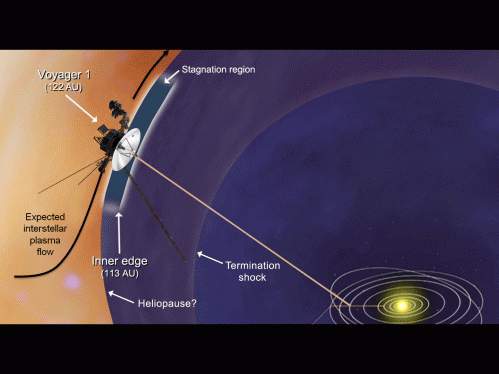After 35 Years of Travel, Voyager 1 Close to Interstellar Space
NASA isn't just about search for traces of life these days.
There are countless other projects happening, such as the first man made space craft that will reach interstellar space, more than 10 billion miles from home.
NASA said that the Voyager 1 spacecraft, which was launched in 1977, has entered "a new region at the far reaches of our solar system that scientists feel is the final area the spacecraft has to cross before reaching interstellar space." The excitement around Voyager subsided in 1990 when it took a "family portrait" of our Solar System and in 1998, when it became Pioneer 10 as the most distant man-made object from Earth. Voyager 1 is estimated to have enough power to communicate with Earth until at least 2025, 48 years after its launch.
It was not until 2004 when Voyager 1 crossed into the heliosheath and interest in the spacecraft, which carries a famous golden record with stored photos of Earth, music samples, and spoken greetings, got traction again. NASA says Voyager 1 is now in a region referred to as "magnetic highway for charged particles".
"Although Voyager 1 still is inside the sun's environment, we now can taste what it's like on the outside because the particles are zipping in and out on this magnetic highway," said Edward Stone, Voyager project scientist based at the California Institute of Technology, Pasadena. "We believe this is the last leg of our journey to interstellar space. Our best guess is it's likely just a few months to a couple years away. The new region isn't what we expected, but we've come to expect the unexpected from Voyager."
Voyager 1 and its sister space craft Voyager 2 are not expected to reach the vicinity of another star within 40,000 years.
Contact Us for News Tips, Corrections and Feedback
Get Tom's Hardware's best news and in-depth reviews, straight to your inbox.

Wolfgang Gruener is an experienced professional in digital strategy and content, specializing in web strategy, content architecture, user experience, and applying AI in content operations within the insurtech industry. His previous roles include Director, Digital Strategy and Content Experience at American Eagle, Managing Editor at TG Daily, and contributing to publications like Tom's Guide and Tom's Hardware.
-
rbj What a fantastic human acheivement - and what a brilliant design to still be going strong - well done to all involved!Reply -
aznguy0028 This is so freakin' awesome, considering it's still alive and kicking with technology made back in the 70's.Reply -
HenrikG I couldn't agree more. Super interesting. I'm 32 and it blows my mind that this thing was launched three years before me. hahaReply -
drwho1 "Voyager 1 and its sister space craft Voyager 2 are not expected to reach the vicinity of another star within 40,000 years."Reply
Just wake me up then....
do NOT forget to wake me up!
you hear me?
/sarcasm
On a more serious note, it is amazing that it is still working after so many years.
Good job NASA!
-
alidan aznguy0028This is so freakin' awesome, considering it's still alive and kicking with technology made back in the 70's.Reply
and yet i have dealt with 6 360's dieing sense launch... yea... how far we came and how much we regressed.
-
greghome Now, I'm just hoping they're able to get a solar sail probe to catch up and surpass both voyagers ;)Reply -
cookoy Most awesome. Just how it is able to communicate with earth and how earth is able to track such a small object that far away - those are unbelievable feats.Reply -
Temp_Username I bet this spacecraft was 100% american made. Sad they get parts from china now.Reply
